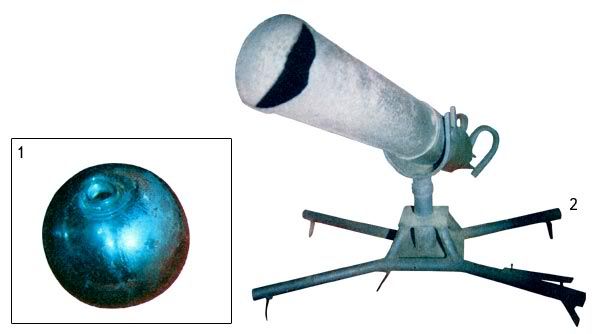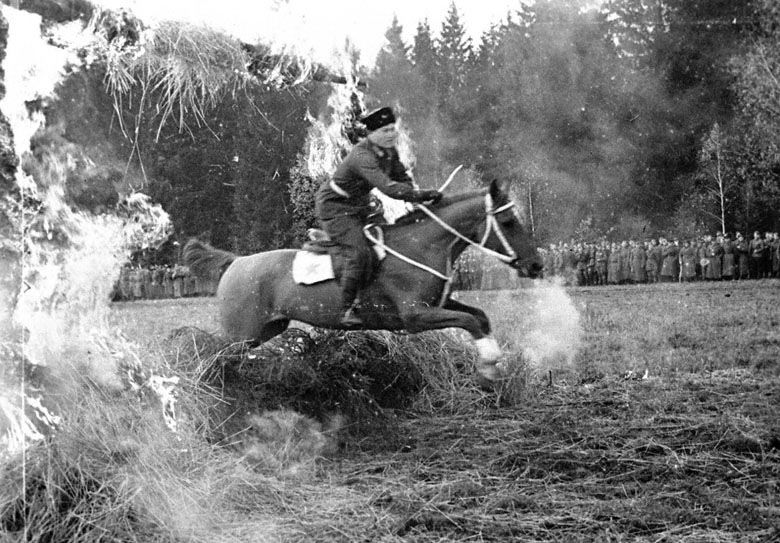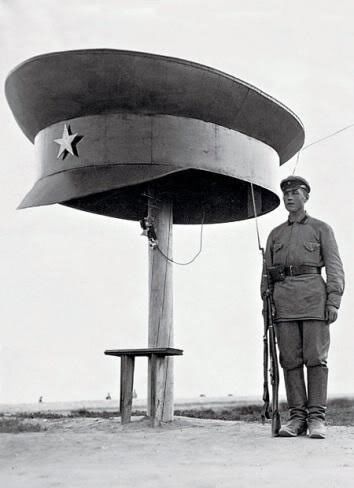Post by horsesoldier176 on Oct 19, 2010 14:10:42 GMT -5
What is it?
It is a very simple weapon that can fire a "KC" Flame
bottle (basically a Molotov) to about 300m. There was a platoon of about 6 weapons attached to the Regimental HQ of a Red Army infantry regiment in 1942.
More info:
Ampulomet: Used for setting fire to facilities. Originally used as a stationary fire weapon by the Red Army, these weapons were so-called "ampulomets", often used for fighting against troops, destroying or blinding the tanks, armoured cars and light vehicles of the enemy, burning out the infantry from shelters and fixed structures.
The ampulomet consisted of a barrel, breech block, bolt, aiming sights, and gun-carriage with a mounting fork. The barrel consisted of a pipe, made from #2 sheet steel. The sights consisted of an unprotected front leaf, and a folding bar rear sight. The barrel was fastened with pins in the fork on the gun-carriage quadpod. The weapon could also be mounted on a frame, then attached to skis for transport.
Ammunition:
A tin ampule "AZH-2", or a glass ball "KC", served as the projectile. Projectiles were launched by firing a .12 gauge shotgun blank.
The weapon itself weighed 10 kg, the quadpod, and gun carriage weighed from 5 to 18 kg, depending on configuration. The range of the weapon is 100 meters, to 400 meters with an additional charge. A gun crew is composed of 3 men. Rate of fire is 6-8 rounds per min.
Loading was done by two men. Number one inserted a vyshibnoy cartridge into the breech chamber. The number two inserted a projectile into the barrel from the muzzle.
The ampulomet were very simple and cheap "flame-thrower mortars". Special ampulometnye platoons were armed with this weapon.
Training regulations for infantry, 1942 mention the ampulomet as a regular fire weapon for infantry. In combat of ampulomet often served as the basis of a tank destroyer unit.
Use of the ampulomet in defensive operations, on the whole, demonstrated it's usefulness, but attempts to use ampulemeti for offensive actions, resulted in severe losses of crews, because of the short range. They were utilized by the assault engineers in city fights, Stalingrad in particular.
By the end of 1942 ampulomety production ceased, and the weapon was removed from the list of officially used weapons in the Red Army.
45 years after the end of the Great Patriotic War the principle of percussion cap "ognemetaniya" was reincarnated by the introduction of the Soviet infantry flame-thrower RPO "Bumble-bee". Among the other "ancestors" of the RPO is the German disposable recoil-less flame-thrower "Einstossflammenwerfer 44", unlike the "Pantserfaust", that threw out a grenade, the "Einstossflammenwerfer 44", launched a stream of burning liquid out to a distance 27 meters. Unlike ampulomets, this flame-thrower remained experimental.
I've seen photos and film of these used by the Red Army in Stalingrad. The configuration they were using in the film, resembled a PanzerShreck. They had removed the mount and added a blast shield. Oh... and it was a 2 man crew.
An ampulomet discovered in the woods outside "Stalingrad"

General configuration:








One of the glass "KC" projectiles:

Now, wouldn't this be a cool weapon for someone with the metal working skills to fabricate, just for display!
Boridin
It is a very simple weapon that can fire a "KC" Flame
bottle (basically a Molotov) to about 300m. There was a platoon of about 6 weapons attached to the Regimental HQ of a Red Army infantry regiment in 1942.
More info:
Ampulomet: Used for setting fire to facilities. Originally used as a stationary fire weapon by the Red Army, these weapons were so-called "ampulomets", often used for fighting against troops, destroying or blinding the tanks, armoured cars and light vehicles of the enemy, burning out the infantry from shelters and fixed structures.
The ampulomet consisted of a barrel, breech block, bolt, aiming sights, and gun-carriage with a mounting fork. The barrel consisted of a pipe, made from #2 sheet steel. The sights consisted of an unprotected front leaf, and a folding bar rear sight. The barrel was fastened with pins in the fork on the gun-carriage quadpod. The weapon could also be mounted on a frame, then attached to skis for transport.
Ammunition:
A tin ampule "AZH-2", or a glass ball "KC", served as the projectile. Projectiles were launched by firing a .12 gauge shotgun blank.
The weapon itself weighed 10 kg, the quadpod, and gun carriage weighed from 5 to 18 kg, depending on configuration. The range of the weapon is 100 meters, to 400 meters with an additional charge. A gun crew is composed of 3 men. Rate of fire is 6-8 rounds per min.
Loading was done by two men. Number one inserted a vyshibnoy cartridge into the breech chamber. The number two inserted a projectile into the barrel from the muzzle.
The ampulomet were very simple and cheap "flame-thrower mortars". Special ampulometnye platoons were armed with this weapon.
Training regulations for infantry, 1942 mention the ampulomet as a regular fire weapon for infantry. In combat of ampulomet often served as the basis of a tank destroyer unit.
Use of the ampulomet in defensive operations, on the whole, demonstrated it's usefulness, but attempts to use ampulemeti for offensive actions, resulted in severe losses of crews, because of the short range. They were utilized by the assault engineers in city fights, Stalingrad in particular.
By the end of 1942 ampulomety production ceased, and the weapon was removed from the list of officially used weapons in the Red Army.
45 years after the end of the Great Patriotic War the principle of percussion cap "ognemetaniya" was reincarnated by the introduction of the Soviet infantry flame-thrower RPO "Bumble-bee". Among the other "ancestors" of the RPO is the German disposable recoil-less flame-thrower "Einstossflammenwerfer 44", unlike the "Pantserfaust", that threw out a grenade, the "Einstossflammenwerfer 44", launched a stream of burning liquid out to a distance 27 meters. Unlike ampulomets, this flame-thrower remained experimental.
I've seen photos and film of these used by the Red Army in Stalingrad. The configuration they were using in the film, resembled a PanzerShreck. They had removed the mount and added a blast shield. Oh... and it was a 2 man crew.
An ampulomet discovered in the woods outside "Stalingrad"

General configuration:








One of the glass "KC" projectiles:

Now, wouldn't this be a cool weapon for someone with the metal working skills to fabricate, just for display!
Boridin



